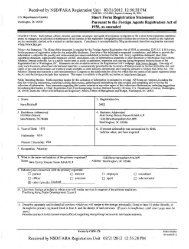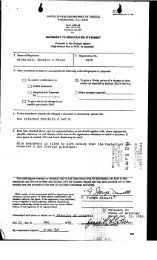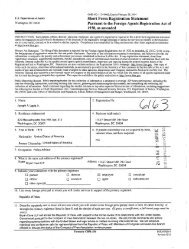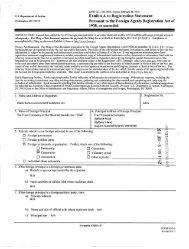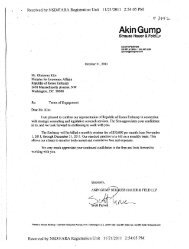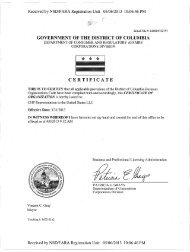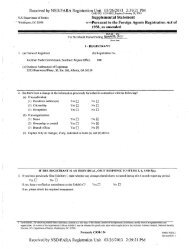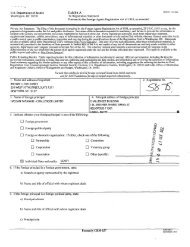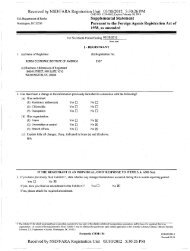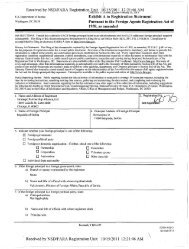Supplemental Statement - FARA
Supplemental Statement - FARA
Supplemental Statement - FARA
You also want an ePaper? Increase the reach of your titles
YUMPU automatically turns print PDFs into web optimized ePapers that Google loves.
H,.<br />
eceived bv NSD/<strong>FARA</strong> Registration Uni<br />
ta/?cf Information<br />
.j«w.*<br />
The mountain ranges of Tasmania's South West date backioo million years when ancient sediments were deeply buried, folded and heated<br />
under enormous pressure to form glistening white quartzites and schists. In the South West and central highlands, there are remnants of a<br />
dolerite plateau cap mountains such as Precipitous Bluff and Tasmania's highest peak, MtQssa. Nearly 37 percent of Tasmania is made up<br />
of World Heritage Area, National Park, Conservation Area's and Reserves (data retrieved May 2007).<br />
Flora<br />
Vegetation is diverse, from alpine heathlands and tall open eucalypt forests to large areas of temperate rainforests and moorlands. Many<br />
plant species are unique to Tasmania; their ancestors grew on the ancient supercontlnent called Gondwana, before it broke up 50 million<br />
years ago. Unique native conifers include Huon pines, with one strand ofthe trees on Mt Read estimated to be up to 10,000 years old, Kings<br />
lomatia, commonly known as Kings Holly, and probably the oldest living plant on earth, was discovered in 1937 Botanists have determined<br />
that only 500 specimens ofthe plant exist in Tasmania's remote south-west wilderness and believe that one ofthe plants, which reproduce<br />
by cloning, has lived in the area for at least 43,000 years.<br />
Fauna<br />
Tasmania is the last home of several species that once roamed the Australian continent. It is the only place to see a Tasmanian devil,<br />
eastern quoll and spotted-tailed quoll in the wild. The striped Tasmanian tiger, or thylacine, was Australia's largest carnivorous marsupial<br />
and is a modern-day mystery. The last documented tiger died in captivity in 1936 and though the animal is considered extinct, there have<br />
been many unsubstantiated sightings since then.<br />
History and Heritage<br />
Aboriginal people have lived in Tasmania for about 30,000 years, well before the last Ice Age. They were separated from the Australian<br />
mainland about 12,000 years ago when the seas rose to form Bass Strait and flooded the landbridge.<br />
Tasmania was originally named Van Diemen's Land by the Dutch explorer Abel Tasman in 1642. The island was settled by the British as a<br />
penal colony in 1803 and the name was changed to Tasmania when convict transportation stopped in 1853.<br />
Tasmania has preserved a rich legacy of heritage, including Australia's oldest continuously operating theatre, the Theatre Royal in Hobart;<br />
the country's first Jewish Synagogue, still in use in Hobart; and its oldest golf course, in the historic town of Bothwell. The nation's oldest<br />
bridge and church are at Richmond, and on the corner of Murray and Macquarie streets in Hobart, the only remaining Georgian intersection<br />
in the country. Many colonial dwellings are in use as private homes or tourist accommodation.<br />
discovertasmania.com Tasmania<br />
Received by NSD/<strong>FARA</strong> Registration Unit 05/01/2012 4:09:43 PM<br />
»wy_»




